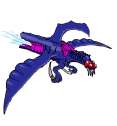| >> |
04/21/12(Sat)20:36 No.18808036
File: 1335054978.png-(39 KB, 531x576, gliding wespar.png)
 Some wespar develop long wide wings, with grooves that guide air trough them more swiftly. These wings allow the creatures to conserve energy, as they can glide trough the air currents and winds with minimal thrusts.
They hunt by flying very high, then waiting for a suitable prey to come in to their sights. They have evolved very acute eyes, which allows them to spot prey from many miles away.
When they have noticed their prey, they start gliding towards it, slowly at first, but as they descend they gain more and more momentum as gravity pulls them towards the ground.
When they are close to their target, they ignite their "engines" to gain a final thrust of speed.
They extend their sharp claws, and slice their victim with uncanny accuracy. Eyes, tendons, everything soft will be targeted by these small swarming organic jet-fighters.
They also spit digestive acids to these wounds, causing crippling pain in the victim. Eventually, the prey will succumb, due the acidulous burns in thousands of small incisions.
The wespar will gorge on their kill, mate, lay eggs and then take off again, starting the whole hunt all over. |

